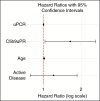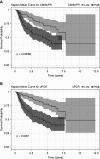Clinical Significance of Immune Deposits and Complement System Activation in FSGS: Findings from the Cure Glomerulonephropathy Network Study
- PMID: 40168593
- PMCID: PMC12407132
- DOI: 10.34067/KID.0000000787
Clinical Significance of Immune Deposits and Complement System Activation in FSGS: Findings from the Cure Glomerulonephropathy Network Study
Abstract
Key Points:
Complement activation plays a critical role in FSGS pathogenesis and progression.
The urine soluble C5b9 protein ratio is emerging as a significant biomarker for FSGS progression.
Targeting complement pathways and monitoring urinary soluble C5b9 levels may improve risk stratification and therapeutic approaches in FSGS.
Background: The interplay between complement activation and the immune response in FSGS warrants further investigation. We investigated the association of glomerular C3 and IgM immunostaining with FSGS disease activity, complement system activation, chronicity on kidney biopsy, and initial and follow-up clinical data in the Cure Glomerulonephropathy Network FSGS cohort.
Methods: Data for patients with FSGS with available pathology assessment from the Cure Glomerulonephropathy Network cohort were reviewed. We tested associations between glomerular immunoglobulins and C3 staining intensity by immunofluorescence with the Columbia classification, the urinary membrane attack complex (soluble C5b9 [sC5b9]) level, proteinuria, and time to a composite outcome, defined by ESKD or a 40% decline in eGFR. Urinary sC5b9 levels, expressed as ratios to creatinine (sC5b9-to-creatinine ratio) and to protein (urine sC5b9-to-creatinine ratio-to-protein ratio [C5b9uPR]), were also examined.
Results: The study cohort comprised 175 patients with FSGS, including 63 (36%) incident subjects enrolled within 6 months of pathology review. Glomerular IgM, C3, and IgG deposits were found in 88 (50%), 48 (27.4%), and 27 (15.4%) patients, respectively. C3 deposition was correlated with global sclerosis (r=0.27, P < 0.001), tubular microcystic changes (r=0.19, P < 0.01), interstitial fibrosis (IF) tubular atrophy (r=0.17, P = 0.03), interstitial inflammation (r=0.17, P = 0.03), and tip lesion (r=-0.16, P = 0.04). In incident patients, C5b9uPR correlated with total segmental sclerosis (r=0.35, P < 0.01), IF (r=0.33, P = 0.01), IF tubular atrophy (r=0.35, P < 0.01), and interstitial inflammation (r=0.29, P = 0.03). Only C5b9uPR (hazard ratio, 1.64 [95% confidence interval, 1.03 to 2.60; P = 0.03]) and age at enrollment (hazard ratio, 1.01 [95% confidence interval, 1.00 to 1.03; P = 0.02]) were significantly associated with the composite outcome in the adjusted Cox survival models.
Conclusions: C5b9uPR is emerging as a significant biomarker for FSGS progression, reflecting the complex interplay between complement activation, inflammation, and kidney injury. The evidence suggests that elevated C5b9uPR levels are associated with poor kidney outcomes and may serve as a valuable tool in the noninvasive assessment of kidney fibrosis and disease progression.
Keywords: biomarkers; collapsing FSGS; complement; proteinuria.
Conflict of interest statement
Disclosure forms, as provided by each author, are available with the online version of the article at
Figures






References
Grants and funding
LinkOut - more resources
Full Text Sources
Research Materials
Miscellaneous

